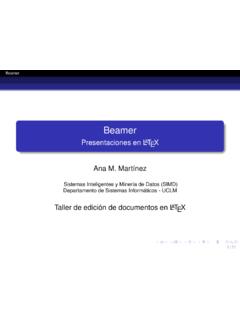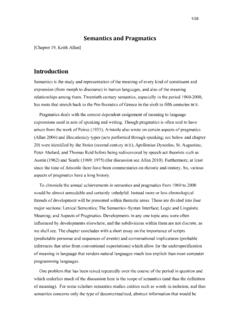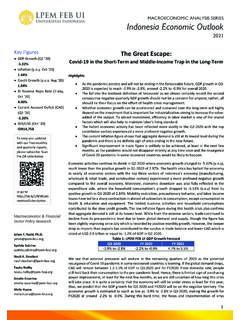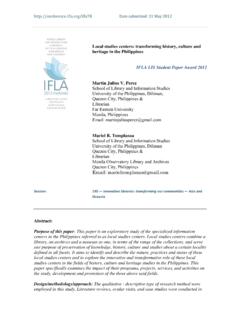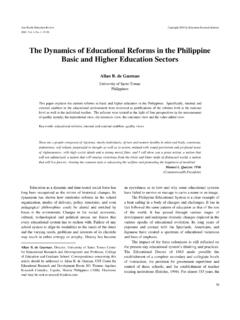Transcription of Nickel Sulfide Versus Laterite - Monash University
1 Nickel Sulfide Versus Laterite : THE HARD SUSTAINABILITY CHALLENGE REMAINS *Gavin M. Mudd1 1 Environmental Engineering, Department of Civil Engineering, Monash University , CLAYTON, Victoria, Australia 3800 (Corresponding author: ABSTRACT There are widespread Nickel resources around the world, but divided principally between Nickel Sulfide or Laterite (oxide) resources. Historically production has been dominated by Sulfide ores but future production is increasing shifting to Laterite ores. The principal reason for this historically is that Sulfide ores are easier to process, through conventional mining, smelting and refining, compared to Laterite ores which require intensive hydrometallurgical processing (such as high pressure acid leaching or HPAL).)
2 This means that Laterite ores typically require substantially more energy and chemicals to produce than Sulfide Nickel . Given that many major Nickel companies report annually on their sustainability performance, such as Eramet, Inco (now Vale Inco), WMC Resources (now BHP Billiton), Norilsk Nickel , there is data available to examine in detail the differences in the environmental costs of Nickel Sulfide Versus Laterite . The paper compiles and analyses a range of data, showing the higher energy costs of Laterite projects, but also the critical importance that energy sources can have on overall environmental costs.
3 Given that the world is continuing to demand Nickel , and most uses are somewhat dissipative which limit high rates of recycling, the progressive shift to Nickel Laterite projects in the global Nickel industry is perhaps inevitable, but it will clearly come at higher environmental costs for Nickel production. Based on present technology and research, there appears little hope for any alternatives which might significantly reduce the environmental costs of Nickel Laterite projects. The big sustainability challenges such as energy and greenhouse emissions therefore remain of paramount importance to the Nickel sector.
4 Full Reference: Mudd, G M, 2009, Nickel Sulfide Versus Laterite : The Hard Sustainability Challenge Remains. Proc. 48th Annual Conference of Metallurgists , Canadian Metallurgical Society, Sudbury, Ontario, Canada, August 2009. INTRODUCTION Nickel is an important metal in modern infrastructure, with major uses in stainless steel (~65%), metal alloys (~20%) and plating (~9%), as well as electric batteries and chemicals [1]. Economic resources of Nickel are found in either Sulfide or Laterite -type ores. Globally, the bulk of historic production has been derived from Sulfide ores, while the majority of Nickel resources are contained in Laterite ores.
5 The difference between production and resources is due mainly to the difficulty associated with processing Laterite compared to Sulfide ores leading to a historical preference for Sulfide ores. To meet future demand for Nickel , however, there is an increasing proportion of Nickel being mined from Laterite ores. This leads to an important issue in terms of the environmental costs of Nickel as Laterite Nickel increases, the footprint per tonne of Nickel metal could be expected to increase. This paper seeks to analyse and contrast the environmental sustainability metrics of existing Nickel production from Sulfide mines with more recent Laterite projects, thereby leading to an important contribution on the environmental sustainability of a critical metal for modern infrastructure.
6 Nickel RESOURCES AND MINING Global Nickel (Ni) production has increased significantly, including near exponential growth since 1950, from some 10,000 tonnes Ni (t Ni) in 1900 to about million tonnes (Mt Ni) in 2007, shown in Figure 1 (including consumption). Based on the present global mining boom led by Chinese demand (amongst other factors), it is most likely that the increasing trend for Nickel production and consumption, evident in Figure 1, will continue for a considerable period of time (despite the current global financial crisis). The principal issue associated with such a scenario is the environmental sustainability of this Nickel production and consumption.
7 & Consumption (Mt Ni)ProductionConsumptionLinear Trend Line(1950-2007 only)~ growth/year Figure 1 Global Nickel production and consumption, including linear trend line for production [2-4] As a metal, Nickel would commonly be considered a finite resource and therefore mining is intrinsically unsustainable. However, there are still abundant Nickel resources known around the world, principally in Australia, Canada, New Caledonia, Philippines, Indonesia and Russia, amongst others. According to the US Geological Survey, global economic and sub- economic resources in 2008 were estimated at 220 Mt Ni [5] a figure whose magnitude has been similar for at least a decade, and even shows a gradual increase over this time (see earlier editions of [5]; resources in 1998 were 180 Mt Ni).
8 Nickel is commonly present in two principal ore types Sulfide or Laterite ores. Sulfide ores are typically derived from volcanic or hydrothermal processes and usually include copper (Cu) and/or cobalt, and sometimes other precious metals such as gold or platinum and palladium (generally grouped as platinum group metals or PGMs). Laterite ores are formed near the surface following extensive weathering, and occur abundantly in tropical climates around the equator or arid regions of central Western Australia or southern Africa. Historically, most Nickel production has been derived from Sulfide ores with Laterite ores providing only a modest source.
9 In terms of known Nickel resources, approximately 60% is found in laterites while 40% is contained in sulfides [5] the reverse of production. The major reason for this is the difficulty of processing Nickel laterites compared to sulfides Laterite ores require extensive and complex treatment to extract Nickel , and has historically been more expensive than Sulfide ores. There have been very few mining projects extracting Laterite ores, and these examples have had major technical and financial difficulties that took several years to resolve satisfactorily ( Moa Bay in Cuba or Greenvale-Yabulu in Australia).
10 The mining, processing and smelting of Sulfide ores follows conventional pyrometallurgical technology and is well understood and implemented. From the late 1990 s, major new Ni Laterite projects have been developed using improvements in materials and processing technology such as high pressure acid leaching (HPAL). Although some were financial and technical failures ( Cawse and Bulong, Western Australia), the Murrin Murrin (WA) project survived and is now producing near design capacity. At present several new Nickel Laterite projects are under development or recently entered production around the world, including Goro and Koniambo in New Caledonia, Ravensthorpe (WA) and Sorowako in Indonesia, with other projects being actively planned.


